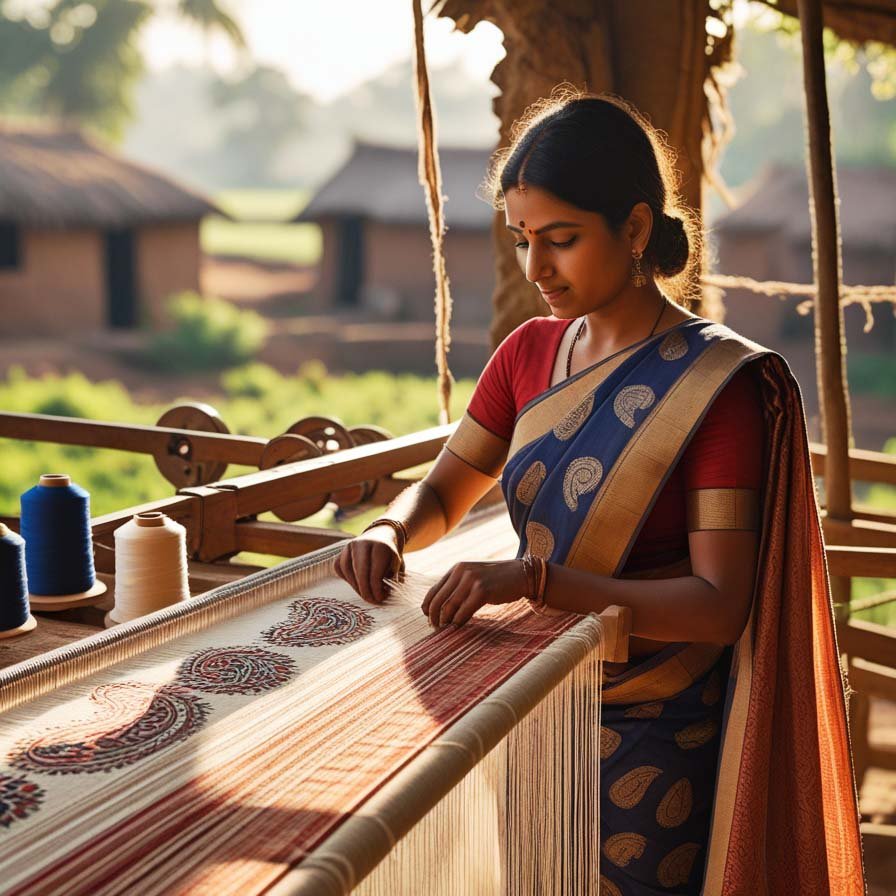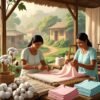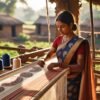
New Finds From Handloom Sarees
Nestled along the banks of the Hooghly River in West Bengal’s Nadia District, the quiet town of Shantipur whispers tales of a centuries-old legacy one spun from cotton threads and woven with patience, skill, and cultural pride. The Shantipur handloom saree, a symbol of Bengal’s textile heritage, is more than just a garment; it is a living testament to the artistry of generations of weavers who have kept this craft alive through resilience and innovation. This article delves into the history, craftsmanship, and cultural significance of Shantipur sarees, exploring why they remain a cherished heirloom in India’s handloom tapestry.
A Legacy Woven in Time: The History of Shantipur Sarees.
The origins of Shantipur sarees trace back to the 15th century, when skilled weavers from present-day Bangladesh (then East Bengal) migrated to Nadia under the patronage of Vaishnava saints. These artisans settled in Shantipur, a town already steeped in spiritual and cultural fervor due to its association with Sri Chaitanya Mahaprabhu. Over time, the sarees evolved, blending Mughal influences with indigenous Bengali aesthetics.
By the 18th century, Shantipur emerged as a hub for fine cotton weaving, attracting royal patronage from the Nawabs of Bengal and later the British East India Company. The sarees were renowned for their feather-light texture, intricate motifs, and durability, making them a favorite among Bengali women for daily wear and special occasions alike.
The Artistry Behind the Loom: Crafting a Shantipur Saree.
What sets a Shantipur saree apart is its meticulous craftsmanship, a process that remains largely unchanged for centuries:
The Cotton:
Shantipur sarees are traditionally woven from high-quality, locally sourced cotton. The yarn is hand-spun to achieve a fine, breathable texture ideal for Bengal’s humid climate.
The Dobby Weave:
The signature “dobby” weave a technique using a manual pedal loom creates geometric patterns, floral butis (small motifs), and stripes. Unlike mechanized looms, this method allows for subtle variations, ensuring each saree is unique.
Borders and Pallu:
The sarees are celebrated for their ‘par’ (border) and ‘anchal’ (pallu). Traditional borders feature ‘kalka’ (paisley) or ‘phool-patti’ (leaf-and-flower) designs, often woven with contrasting threads. The pallu may include intricate jamdani or supplementary weft patterns.
Natural Dyes:
While modern sarees use chemical dyes, purists still prefer vegetable-dyed threads for earthy hues like indigo, turmeric yellow, and madder red.
Varieties of Shantipur Sarees.
Gamchha Sarees: Ultra lightweight cotton sarees, originally woven as towels, now reimagined as casual wear.
Garad-Korial: A lustrous silk cotton blend, often in white or cream with red borders, worn during festivals like Durga Puja.
Jamdani-Inspired: Delicate floral motifs woven into the fabric, resembling Dhaka jamdani but with a distinct Shantipur flair.
Cultural Significance: More Than Just a Saree.
For Bengali women, the Shantipur saree is a canvas of identity. Its simplicity embodies grace, while its durability reflects the resilience of rural life. It is a staple in:
Modern Fashion: Designers are reinventing Shantipur weaves with contemporary prints, palettes, and fusion silhouettes.
Daily Wear: Preferred for its comfort and breathability.
Festivals and Rituals: The red-and-white
Garad-Korial is synonymous with Durga Puja and weddings.
Challenges and Revival: Sustaining the Craft.
Despite their timeless appeal, Shantipur weavers face challenges:
Declining Artisan Numbers: Younger generations are abandoning the craft for urban jobs.
Competition from Power Looms: Mass-produced imitations threaten livelihoods.
Efforts to Preserve the Legacy.
Geographical Indication (GI) Tag: Awarded in 2020, this protects the Shantipur saree’s authenticity.
Government and NGO Initiatives: Schemes like the *Handloom Development Corporation provide subsidies, training, and market access.
Social Enterprises: Brands like Tantuja and Weavers Studio collaborate directly with weavers, ensuring fair wages.
Why Choose a Shantipur Saree?
- Ethical Fashion: Supports rural artisans and sustainable practices.
- Timeless Appeal: Transgenerational elegance that never goes out of style.
- Cultural Connection: Owning a Shantipur saree is akin to preserving a piece of Bengal’s soul.
How to Identify an Authentic Shantipur Saree.
- Look for slight irregularities in the weave proof of human hands at work.
- Check the GI tag or buy from certified cooperatives like Banglar Tant or Manjusha.
- The saree should feel soft yet sturdy, with a matte finish characteristic of handloom cotton.
Conclusion: Weaving the Future, Honoring the Past.
Shantipur sarees are not just textiles; they are stories woven in thread. Each fold carries the sweat, dreams, and heritage of the weaver. As conscious consumers, choosing these sarees helps sustain a craft that has clothed generations and embodies the spirit of Bengal.
Explore the Collection.
Visit Nadia’s weaving clusters or trusted online platforms like alpanahighfashion.com and India Handloom Hub to bring home a Shantipur masterpiece.


